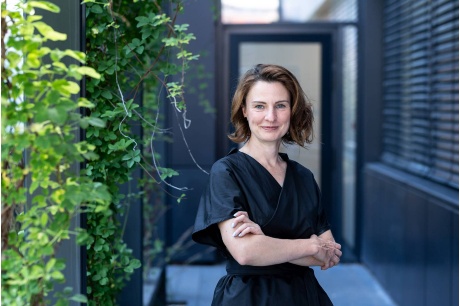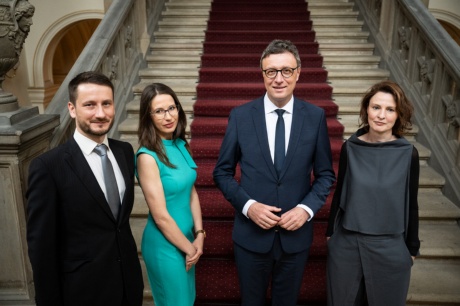
Let’s be ambitious, say leaders of the Dioscuri Centers at the Academy
19. 08. 2024
The secrets of life at the molecular level and addressing the increasing energy demands of information technology – what the two Dioscuri Centers of Scientific Excellence established at the Institute of Physics of the CAS are focusing on. Led by Barbora Špačková and Helena Reichlová, these centers explore how international collaboration can advance Czech science and what their teams hope to achieve.
The Dioscuri Program was initiated by the Max Planck Society, aiming to foster scientific excellence and cooperation in Central and Eastern Europe while bridging the gap between Western and Eastern European science. As emphasized by Patrick Cramer, President of the Max Planck Society, during the opening ceremony of the Czech Dioscuri Centers, even twenty years after the expansion of the EU, scientific excellence within the European Research Area remains unevenly distributed.
The program supports young researchers at their home institutions in collaboration with a German partner. After Poland, the Czech Republic is only the second country where Dioscuri Centers have been established – two at the Institute of Physics of the Czech Academy of Sciences (CAS) and one at the Faculty of Science at Masaryk University. In the fall of 2024, another call is set to be launched to select two more centers.
Sustainable IT
Helena Reichlová leads the Dioscuri Center for Spincaloritronics and Magnonics. Her team is developing new concepts for sustainable and energy-efficient information technology. “In today’s world, the amount of information and data is growing exponentially, and so is the energy demand of IT. This is a problem that needs to be addressed,” Reichlová says.
One approach is to discover new principles for transmitting and processing information, such as using waves of the electrons’ spins, known as magnons. “A spin wave can be used to transfer information instead of the currently used moving electrons. If we need to transfer information from point A to point B, then, the electron can stay in place and transmit information by tilting its spin in a controlled manner,” the researcher explains.
You can learn more about Helena Reichlová’s research here.
The unexplored world of molecules
“I work in bionano-optics, which allows me to examine life at the molecular level. At the Dioscuri Center, we focus on studying biomolecular interactions and molecular transport with the aim of applying these findings in biomedicine,” Barbora Špačková explains.
Crucial biological processes occur at the nanometer scale – a billion times smaller than the size of a human body – where molecules control its complex functions. However, many questions about molecular processes remain unanswered due to the limitations of current microscopy. The Dioscuri Center of Single-Molecule Optics, which Špačková leads, aims to develop experimental methods that would enable the study of life at the molecular level in real-time and in its natural state – something that has not been possible before.

This photo of Barbora Špačková was taken for an article that will be published in the A / Magazine of the CAS in September 2024, where you can learn more about her research.
“It’s fantastic that the Institute of Physics managed to secure two out of three awarded centers in the inaugural year [of the Dioscuri Program]. This is an opportunity for significant advancement in key research areas that Barbora Špačková and Helena Reichlová are focusing on,” says the director of the institute, Michael Prouza.
As the scientists explain in the interview below, it was the support of a large institution that played a crucial role in their decision to apply for funding.
Two of the three Czech Dioscuri Centers operate as part of the Institute of Physics. Did you two have a unified strategy?
Helena Reichlová: No, actually! Barbora Špačková and I met for the first time during the final interviews. What we did have in common was the support of a large institution that is committed to excellent research on an international scale.
Barbora Špačková: Yes, Helena Reichlová and I met for the first time during the final round of the selection process. We didn’t discuss a strategy. A key factor in our success might have been the strong support from our home institute. I should add that the Institute of Physics is the largest research facility of the CAS, which increases the likelihood of such situations.
How do you view the program compared to other domestic and European funding schemes?
HR: The selection and funding conditions are somewhat reminiscent of the Max Planck Research Group Program – with the difference that, ideally, the selected researcher in the Czech Republic has the perspective and ambition to develop the center even after the Dioscuri Program funding ends. However, the number of Dioscuri Centers in the Czech Republic is limited to five. I was incredibly fortunate that the call was announced at a time when I was at a crossroads career-wise, deciding whether to continue in the Czech Republic or Germany.
BŠ: The program offers stable and long-term funding. It provides five years of support with the possibility of extension up to ten years, which is often longer than other grant schemes. This allows for planning long-term projects and investing in quality infrastructure. Competitive salaries for the team, meeting European standards, also help attract talent from around the world. The individualized approach of the program, tailored to the specific needs of each team, is also a unique factor.
What is your take on the persisting differences in research output between Western and Eastern/Central Europe? What are the shortcomings of the Czech research system and its funding?
HR: The performance gap between Western and Central/Eastern Europe is unfortunately a fact, which was also one of the motivations behind the creation of the Dioscuri Program. It certainly goes hand in hand with the amount of money that is invested in research and development. However, I also believe that resources should primarily be directed towards local centers of excellent research and to supporting research groups that have the potential to reduce this performance gap. The Czech system would also benefit from greater internationalization, which again is tied to funding. For instance, we could establish more contacts with research groups abroad and support the mobility of top researchers at all career levels in both directions. Thanks to the Czexpats in Science initiative, we know of many outstanding Czech researchers abroad who could be natural partners for such exchanges.
BŠ: Czech research institutions often suffer from a lack of funding necessary for investments not only in infrastructure modernization, but also human capital and education. The salaries of university lecturers, postgrad students, and researchers are very low compared to other countries. Unsurprisingly, this leads to low motivation and a departure from academia. Another issue is the excessive bureaucracy associated with grants. Additionally, the level of control and inflexibility of the system is disproportionate.
A requirement for applying is a German research partner. How can Czech–German cooperation help advance Czech science?
HR: Our partner is a renowned senior researcher who has been significantly helping our center, and thus Czech science, from a scientific standpoint. However, he is not only an important collaborator but also a mentor who assists me with strategic or personnel decisions without being influenced by experiences in the Czech environment. His fresh perspective allows me to assess whether something could be done differently. Dioscuri also has a budget allocated to Czech–German activities, which in our case will comprise international workshops in the Czech Republic or Germany. Through these, we aim to contribute to the development of – not just – Czech science.
BŠ: Yes, Czech–German cooperation can significantly contribute to the advancement of Czech science. This holds true for any international collaboration. Partnerships with research groups from different countries provide access to a portfolio of technologies, knowledge, and experience, thereby increasing the quality and competitiveness of the research. Student exchanges are also important, as these allows students to gain experience and professional contacts that can be crucial for their future careers.
How large is your team?
HR: At the moment, we have about eight people in my team, many of whom work part-time or on a (shorter) work agreement. We have two PhD students and one postdoc researcher working full-time.
BŠ: I am currently assembling a team of four scientists – two postgrad students and two postdoc researchers with diverse specializations, ranging from physics and data analysis to biological sciences. The team also includes a project coordinator. However, finding the last piece of the puzzle, a postdoc with a background in physics, has proven to be the most challenging. I still have an open call and am searching for the right candidate.

From left to right: Peter Fabian (Faculty of Science, Masaryk University), Helena Reichlová, Patrick Cramer (President of the Max Planck Society), Barbora Špačková.
What goals have you set for the five-year period?
HR: In basic research, it’s difficult to set goals for what we will achieve in five years. Generally speaking, we want to better understand spin-caloritronic and magnonic phenomena in antiferromagnets and altermagnets and find materials where these phenomena will be able to be largescale and robust. We will also strive to secure additional funding for the center so that we’ll be able to naturally expand. It is also important to maintain an international network of contacts and foster cooperation not only with our German partner.
BŠ: Our aim is to develop a new generation of optical microscopy that will allow us to study biological processes at the single-molecule level, in their native state, with minimal interference. We are trying to address some of the most pressing biological questions of today. This could lead to breakthroughs in early diagnostics, therapeutic interventions, and the development of new biotechnologies.
What do you think made your project stand out to the evaluators?
HR: The evaluators had to assess many aspects, so I wouldn’t dare guess what specifically caught their attention in regard to my project. It’s likely different for each member of the committee.
BŠ: Unfortunately, the selection process did not allow us to view the evaluations of the applications, as is common in other grant programs. I can thus only speculate on what was crucial for success. From my discussion with the committee members during the interview, I got the impression that they were intrigued by the program’s broad scope, which has the potential to impact various research fields at once.
What was important during the evaluation of your application? Did anything surprise you?
HR: The key was to present the concept more as a long-term vision rather than a one-off project. This aligns with the motivation behind the Dioscuri Program: to create sustainable local centers of high-quality research with the potential to gradually attract additional activities and funding. I was perhaps surprised by the flexibility of the application format, which doesn’t require a mandatory structure like I’ve been used to with grant applications for the Deutsche Forschungsgemeinschaft and the Czech Science Foundation. I’m also pleasantly surprised by the relatively low administrative burden and the personalized approach.
BŠ: The Dioscuri call required us to present an innovative research concept that has potential for future growth – one that could become a beacon of scientific excellence and meet international standards of research. On the one hand, such an assignment is quite abstract, but it allows us to express what we ourselves consider important for the future of science.
Will the support help you apply for other forms of grants, such as ERC grants?
HR: I’ve started writing an ERC grant application several times but have not yet submitted it. Regardless of the Dioscuri Program, applying for an ERC grant is definitely on my agenda. As I mentioned, Dioscuri expects its researchers to apply for various national and international grants, so I do consider that as a form of support on their part.
BŠ: I believe that Dioscuri’s support will indeed help researchers apply for additional grants, including the prestigious ERC grants. At the Institute of Physics, we also have excellent grant admin support, offering consultations, advice, and administrative assistance, with a long history of successfully securing this type of grant.
Two more Dioscuri Centers are to be opened in the Czech Republic. What advice would you give to researchers preparing for the second call?
HR: I’m not sure if succeeding in the Dioscuri Program qualifies me to give advice to future applicants. But I would suggest starting the project preparation early, attending online workshops related to the program, contacting the grant office of the potential host institution in the Czech Republic, and finding out if the institution is even interested in hosting the center and how willing they are to support it. The research proposal itself should be ambitious, with a sufficiently detailed and coherent plan for the sustainable growth and development of the center beyond the Dioscuri funding horizon.
BŠ: Don’t be afraid to take on big challenges and set ambitious goals. It’s also important to remember that success in grant competitions is partly a matter of being in the right place at the right time – something you can influence by pushing forward and not giving up. After all, the probability of success increases with the number of unsuccessful attempts.
Written and prepared by: Zuzana Dupalová and Luděk Svoboda, External Relations Division, CAO of the CAS, drawing on the CAS news story and the Institute of Physics press release
Translated by: Tereza Novická, External Relations Division, CAO of the CAS
Photo: Shutterstock; Jana Plavec, External Relations Division, CAO of the CAS; René Volfík for the Institute of Physics of the CAS
Read also
- Renewables are a strategic investment in European security, scientists say
- New record set for neutrino mass: one million times less than an electron
- On the trail of the endangered little owl: searching for newly hatched owlets
- Teen scientist breaks barriers: No child is a lost cause
- The Czech Academy of Sciences has appointed its new leadership for 2025–2029
- Literature is tied to its historical context. How can we read between the lines?
- Radomír Pánek: The Academy must be united, strong, and proactive
- A springtime booster: The healing potential of tree buds
- A novel compound that protects bone cells may benefit diabetic patients
- New interactive exhibition at the CAS showcases materials shaped by genius ideas
The Czech Academy of Sciences (the CAS)
The mission of the CAS
The primary mission of the CAS is to conduct research in a broad spectrum of natural, technical and social sciences as well as humanities. This research aims to advance progress of scientific knowledge at the international level, considering, however, the specific needs of the Czech society and the national culture.
President of the CAS
Prof. Eva Zažímalová has started her second term of office in May 2021. She is a respected scientist, and a Professor of Plant Anatomy and Physiology.
She is also a part of GCSA of the EU.